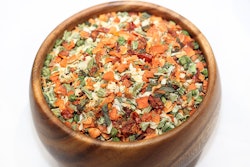
Premiumization is on the rise again in pet food sales in the U.S., after a dip in 2023 driven by high inflation and other COVID-driven economic challenges. According to data presented by the American Pet Products Association (APPA) in March 2025 with the release of their State of the Industry report, and more recently with their new Dog and Cat Report, sales of premium dog and cat food rose 5% and 9%, respectively, in 2024, if not quite reaching their peaks from a couple of years ago. (At least not yet?)
That continuing premiumization encompasses many pet food categories, of course, including so-called alternative formats such as fresh, frozen and freeze dried. While those are still small segments of the pet food market, they are among the fastest growing in sales, not only in value (which in isolation may reflect higher prices resulting from inflation) but also units, according to data from NielsenIQ (NIQ).
Which very likely explains why two large pet food players, Royal Canin and Blue Buffalo, announced launches of new fresh pet food lines in the past two weeks.
One new fresh line on the market, one to come
The Royal Canin line, Fresh Health Nutrition, offers “gently cooked” dog food for three life stages: puppy, adult and senior. For clues to what gently cooked might mean, the company’s announcement said the products require freezer storage until use and should be thawed in the refrigerator 24 hours before serving. Once opened, portions can be refrigerated for up to five days. They’re already available for purchase on Chewy.com and at brick-and-mortar pet retailers.
General Mill’s announcement about its new line, Love Made Fresh, offers less specific information about the products and their availability, other than they’ll be “arriving in stores nationwide later this year.” In fact, it’s not even clear if the line is only for dogs; the announcement repeatedly says “pet food” but also mentions that the products could be used standalone or as a “perfect companion” to Blue Buffalo’s portfolio of dry dog food. It’s also not clear exactly what the products are, with the company saying the line will “feature multiple formats and a variety of flavorful recipes.”
My hunch is that General Mill’s moved up its announcement, which came just a week after Royal Canin’s, before it was really ready for prime time, perhaps hoping to steal a little of a competitors’ thunder.
Will more companies follow into fresh?
Regardless of matters like timing and formats, the new lines make sense for large companies seeking ongoing growth. Fresh and frozen pet food increased 16.1% in value sales and 15.8% in unit sales in 2024, per that NIQ data, released during Global Pet Expo in March. (Unfortunately, NIQ doesn’t break down fresh vs. frozen or define either.) Sales of 100% freeze-dried pet food rose 9.9% in value and 18.6% in units, despite its comparably astronomical average price per pound of US$32.43. (The average price per pound for fresh and frozen in 2024 was US$5.40; for all pet food, it was US$2.53.)
While the NIQ data also shows just how small these categories are — 3.6% for fresh and frozen, only 1.1% for 100% freeze dried — the heady growth rates are difficult to ignore.
Meanwhile, as pet food inflation has slowed significantly, sales of “basic” pet food — what many may call economy-priced products — declined in 2024, down 7% for both dog and cat food, per the APPA data. With cat food, it’s at least still on parity with premium products in terms of market share, with both at 38% in 2024; but the latter is on that upward growth path while economy is on a downward one. With dog food, premium products accounted for a 41% share in 2024, compared to 26% for economy. The up and down trajectories mimic those in cat food.
Whether these trajectories carry through this year and beyond remains to be seen, especially if U.S. tariffs go fully into effect and affect pricing, availability and sales. But considering how premiumization took hold 10 to 15 years ago and has only continued to rise or at least remain steady, no matter the economic conditions, betting on it is wise. So is looking to other high-growth categories for product line and business expansion, as Royal Canin and General Mills are doing. Who else might follow in their footsteps?

















